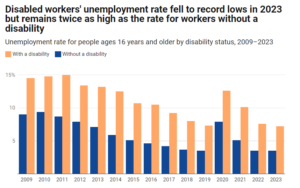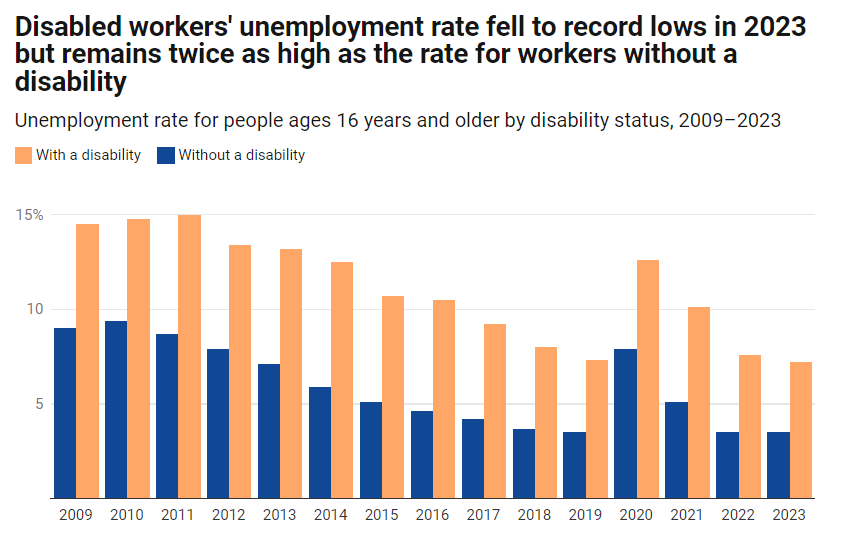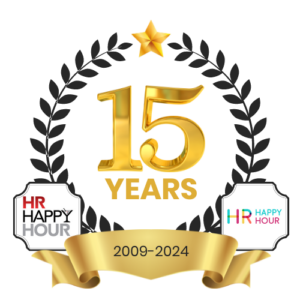Labor Market Focus: Employment Prospects and Participation Improving for Disabled Workers – But Challenges Remain
March 12, 2024
One of the notable labor market developments of the pandemic era was the increase in employment participation and opportunities for people with disabilities. Understanding these communities is an opportunity for organizations who continue to deal with persistently tight labor market conditions.
In 2023, according to the U.S. Bureau of Labor Statistics, 22.5 percent of people with a disability were employed—the highest recorded ratio since comparable data were first collected starting in 2008. The participation rate increased by 1.2 percentage points from 2022. While it’s encouraging that more disabled people are working, the rate at which disabled workers are included in the labor force pales in comparison to the rate for people without disabilities, which sits at about 67.6%.
On other relevant measure of labor market conditions, disabled workers also fare much worse than do non-disabled workers. By the end of 2023 the “headline” unemployment rate for people with a disability (7.2 percent) was little changed from the prior year, while the unemployment rate for those without a disability ended the year at a generational low of 3.5 percent. For disabled workers, the much lower rate of labor force participation along with more than double the rate of unemployment, combine to create a rather disappointing and distressing overall picture.
Further illustrating the challenges disabled workers encounter in the workplace, the BLS notes the following:
For all age groups, the employment-population ratio is much lower for people with a disability than for those with no disability.
Unemployment rates are much higher for people with a disability than for those with no disability across all educational attainment groups.
Workers with a disability are nearly twice as likely to work part time as workers with no disability.
Workers with a disability are more likely to be self-employed than those with no disability – likely reflecting the relative difficulty disabled workers face when seeking employment at established firms.
With these, and other challenges facing them, it may be surprising that during the pandemic era, many measures of disabled worker outcomes saw improvement. Let’s examine a few key data points.
Disabled Workers See Recent Gains in Important Labor Market Measures
But despite the many labor market challenges and historical inequalities that disabled workers have faced, events of the pandemic era, and the ensuing labor market recovery, proved to have a positive influence on disabled workers’ participation rates and overall employment. In truth, disabled people have made notable employment gains, benefiting from opportunities created by the extended tight labor market conditions and the increased workplace flexibility and embrace of remote working.
Employment rates for working-age disabled women and men hit record highs in 2023—36.1 percent and 38.2 percent, respectively. And the chart below shows that “top line” unemployment for disabled workers has declined from 15% in 2011 to 7.2% in 2023 – a dramatic rate of decline (but still not as rapid as the reduction in unemployment for non-disabled workers).

So, the improving labor market since the immediate shock and crash at the onset of the pandemic in early 2020 has indeed benefited disabled workers as well as the average worker. Once the labor market shock began to calm, the combination of surging consumer demand (initially for goods, then once large-scale re-openings began, shifting to services), widespread adoption of remote and flexible working, and the general re-evaluation of the place and role of work in our lives all have led to a general increase in demand and opportunity for workers of all kinds. But to use the old expression “a rising tide lifts all boats”, it remains that for disabled workers their “boat” is much smaller, less secure, and more likely to be left lagging behind, even in fair winds and calm seas. Let’s explore some of the reasons why.
The Complex Nature of Disability
There are numerous reasons why workers are classified in the category of disabled, and often encounter significant challenges and barriers to their participation in the workforce – not surprising in that disabilities themselves take many forms and present different obstacles that need to be overcome and managed. Several types of disabilities can present challenges for individuals in obtaining and maintaining employment. The more common types of disabilities that may impact a person’s ability to get hired and succeed in their job include:
Mobility Impairments: Individuals with mobility challenges, such as paralysis, spinal cord injuries, or mobility-limiting conditions like cerebral palsy. These workers can encounter difficulties accessing workplaces that lack appropriate accommodations, performing certain physical tasks, or navigating the physical environment and conditions within the workplace.
Sensory Impairments: Some workers experience sensory issues like visual impairments, hearing impairments, or other sensory disabilities which can pose challenges in communication, accessing information, and navigating the physical environment. Lack of accommodation for these disabilities may hinder job performance and limit employment opportunities.
Neurodevelopmental Disorders: These are conditions such as autism spectrum disorder (ASD), attention-deficit/hyperactivity disorder (ADHD), or other learning disabilities. Workers in this group may have challenges with social interactions, communicating effectively at work, and perhaps with other cognitive processes, potentially impacting job interviews, workplace interactions, and task performance.
Psychiatric Disabilities: Mental health conditions, such as depression, anxiety disorders, bipolar disorder, or post-traumatic stress disorder (PTSD), can affect concentration, emotional regulation, and interpersonal relationships in the workplace. And even though progress has been made, there still exists stigma surrounding mental illness which may hinder individuals from disclosing their condition or seeking necessary accommodations.
Chronic Health Conditions: Chronic health conditions such as diabetes, chronic pain, autoimmune disorders, or respiratory conditions can impact energy levels, physical stamina, and overall well-being, affecting job performance and attendance.
Intellectual and Developmental Disabilities: These types of disabilities may affect an employee’s cognitive functioning, problem-solving abilities, and adaptive skills necessary for job tasks and effective workplace interaction. Individuals with intellectual or developmental disabilities may require additional support and accommodation to succeed in employment.
Other or Less Visible Disabilities: Some disabilities, such as chronic pain, autoimmune disorders, or certain mental health conditions, may not be immediately apparent to others. Individuals with invisible disabilities may face challenges in obtaining accommodations and may encounter skepticism or disbelief from employers or colleagues
As we can see, the complex nature of and the large and diverse set of disabilities create challenges for the individual and organization. As no two workers are the same, and need to be understood and treated as individuals, so too are no two types or categories of disability the same. The challenges and therefore the potential necessary accommodations needed will change based on these complex dynamics of the characteristics and talents of the person, the type of their disability, cultural aspects in the organization, and of course the nature of the job and work that needs to be done.
It is important to remember these factors even when analyzing macro trends in the labor market. The percentages and metrics we cite in our analysis are aggregated results of hundreds of thousands, even millions of individuals, organizations, jobs, and their personal experiences in the workplace. But while each worker’s experience will be their own, and the circumstances impacting their potential employment unique, there are some consistencies that most disabled workers are likely to encounter at some point. Let’s break down some of the major challenges that many disabled workers face.
Barriers and Challenges for Disabled Workers
Even during the extended tight labor market, and in an environment where many if not most employers struggle to find and retain workers, employment participation and levels of employment for disabled workers persistently lag their non-disabled colleagues. Even though advocates for the disabled community emphasize that many of the employer accommodations needed and requested to make work and workplaces more open to disabled workers are simple, inexpensive, and often benefit all workers, not just the disabled, we still see many obstacles and barriers which disabled workers must navigate.
Some of the primary reasons which can make employment opportunities less attractive and available for disabled workers include:
Lack of Accessibility: Many workplaces lack adequate accessibility features, such as wheelchair ramps, elevators, or accommodations for individuals with sensory impairments. Without these accommodations, disabled workers may struggle to navigate the workplace environment effectively.
Bias and/or Discrimination: Discrimination based on disability remains a significant barrier in the labor market. Disabled individuals may face prejudice, stereotypes, and biases from employers, leading to limited job opportunities and lower wages.
Limited Access to Education and Training: Access to quality education and vocational training programs may be limited for disabled individuals, leading to skill gaps and reduced competitiveness in the job market.
Healthcare and Support Services: Access to healthcare, rehabilitation services, assistive technologies, and support services is essential for many disabled workers to effectively participate in the workforce. However, disparities in access to these services can pose significant challenges.
Lack of Awareness from Employers: Some employers and decision makers (HR staff, hiring managers, etc.), may simply not be aware of the potential source of talent in the disabled community. Employers may sense that accommodations, training needs, or other circumstances make employing disabled workers too difficult or costly.
While these reasons and barriers for employment of disabled workers are real, and often do require intentional and direct efforts to mitigate, none of them truly should make the employment of disabled workers impossible or even impractical. With the right approaches, mindsets, culture, and commitment, most workplaces can become more open and available to all types of disabled workers. Let’s look at some ways and steps that employers can take to create more opportunities for these communities.
Recommendations for Employers
Employers have several strategies and approaches available to them to make their workplaces more accessible, accommodating, and welcoming to employees with disabilities. Chief among the options for employers to consider are:
Accessible Workplace Design: Employers should evaluate their physical facilities to ensure accessibility for individuals with mobility impairments, such as installing ramps, handrails, wheelchair-accessible restrooms, and adjustable workstations. They should ensure there are adequate accessible parking spaces close to the entrance and verify there exist clear pathways throughout the workplace.
Make Reasonable Accommodations the Norm: Employers should establish and implement a process for providing reasonable accommodations to disabled employees, such as assistive technologies, ergonomic equipment, flexible work arrangements, modified schedules, or job restructuring. Leaders should encourage open communication between managers and employees to identify and address individual accommodation needs and make the environment one that where disabled workers can be empowered to advocate for their accommodation needs.
Establish Inclusive Policies and Practices: Develop and enact inclusive policies and practices that promote equal opportunity and nondiscrimination for individuals with disabilities. Train managers and staff on disability awareness, inclusive communication, and best practices for accommodating disabled workers. Ensure that hiring, promotion, and retention practices are free from bias and barriers.
Training and Awareness Programs: Employers can conduct formal disability awareness training for all employees to foster a culture of inclusion, respect, and understanding – including during onboarding of new team members. Provide education on disability etiquette, communication strategies, and the benefits of embracing diversity in the workplace. Encourage employees to be proactive in supporting their disabled colleagues and advocating for inclusive practices.
Assess Workplace Technology for Accessibility: Ensure that workplace technology, including software, websites, and digital communication tools, are accessible to individuals with disabilities. Implement accessibility standards and guidelines, such as the Web Content Accessibility Guidelines (WCAG) and provide training on accessible design and development practices for IT and HRIT teams.
Create a Supportive Workplace Culture: Foster a supportive and inclusive workplace culture where diversity is celebrated, and all employees feel valued and respected. Encourage teamwork, collaboration, and mutual support among employees, regardless of disability status. Address stigma and misconceptions surrounding disability through education and awareness initiatives. Highlight success stories of disabled workers inside and outside of the organization.
Partnerships with Disability Organizations: Establish partnerships with disability advocacy organizations, vocational rehabilitation agencies, and community resources to tap into expertise, support services, and talent pipelines for disabled workers. Collaborate with these organizations to recruit, train, and retain disabled employees and to access funding or incentives for disability inclusion initiatives.
Implementing some or all these strategies will become increasingly important to employers as they continue to struggle with overall low unemployment and tight labor markets, as well as the growing numbers of the disabled population in the United States. Overall, there are about 42.5 million Americans with disabilities, making up 13% of the civilian noninstitutionalized population, according to U.S. Census Bureau data from 2021. This group includes people with hearing, vision, cognitive, walking, self-care or independent living difficulties. Plus, this number is expected to continue to climb, as the full effects of the COVID-19 pandemic have not been folded into official statistics yet.
Conclusion
While disabled workers have made gains in the labor market, as evidenced by the unemployment rate for disabled workers hitting an all-time low recently, the data and the lived experience of disabled workers still reveal that more progress can be made. Employers that can create supportive environments, implement what are often simple inexpensive accommodations, and encourage flexibility can realize the numerous benefits that accrue from this deep and talented workforce.
By implementing these approaches and strategies, employers can create more inclusive and accommodating workplaces that enable disabled workers to thrive and contribute their skills and talents to the organization. Additionally, embracing diversity and accessibility benefits not only disabled employees but also can improve overall workplace morale, productivity, and innovation.
Resources
In addition to the many external support, advocacy, and workforce development organizations that support the access to opportunity and the empowerment of disabled workers, we have showcased several people, organizations, and programs on the HR Happy Hour Media Network. Some examples are below:
Unlocking Potential: Navigating Autism in the Workplace – In this episode, we look at the dynamic landscape of autism in the workplace, shedding light on Autism Speaks’ mission and the myriad employment opportunities for individuals on the spectrum.
Workplace Mental Health Trends and Insights for HR Leaders – We spoke with Melissa Frieswick about about workplace stress and mental health trends for 2024. We talked about the critical aspects of mental health and wellbeing within the workplace, emphasizing the profound impact on the employee as a whole.
Neiman Marcus Continues to Embrace Remote Work, Despite Return to Office Trend – In this episode Steve shares how luxury retailer Neiman Marcus continues to embrace and see the benefits of remote working for its corporate teams.
Challenges Remain for Neurodivergent People in the Workplace – In this episode Steve discusses the challenges facing neurodivergent people in the workplace, and some simple accommodations employers should consider.
Fostering Diversity and Inclusion: How Employee Resource Groups Drive Change – In this episode Mervyn talks to Paul Modley, Director Diversity, Equity & Inclusion at talent solutions business AMS about how to move DEI initiatives up the corporate agenda and the key role that Employee Resource Groups (ERGs) play.

Author
Categories
Tags
Share
How we can help
Led by Trish Steed and Steve Boese, H3 HR Advisors harnesses over 40 years of experience to delivery HCM insights and guidance to global organizations.
H3 HR Advisory services
By leveraging technology, analytics, and our deep industry knowledge we can help you to reposition your workforce and ensure that you have the right people with the right capabilities in the right roles to positively impact the growth of your business.
HR Happy Hour Podcast Network
Created in 2009, The HR Happy Hour Show is hosted by Steve Boese and Trish Steed and is the longest continuously running internet radio show and podcast on Human Resources, HR Technology, Talent Practices, Workplace and Leadership topics.
H3 HR Speaking Services
We work closely with every client to customize your content - keynotes, webinars, research, infographics, and buyer’s guides - to inspire, educate and inform the audience enabling you to reset and realign your organization for a talent-led breakthrough.
Get in touch
Talk to us today and find out how we can help you and your organization leverage HCM technology to attract, onboard, retain and manage top talent.



